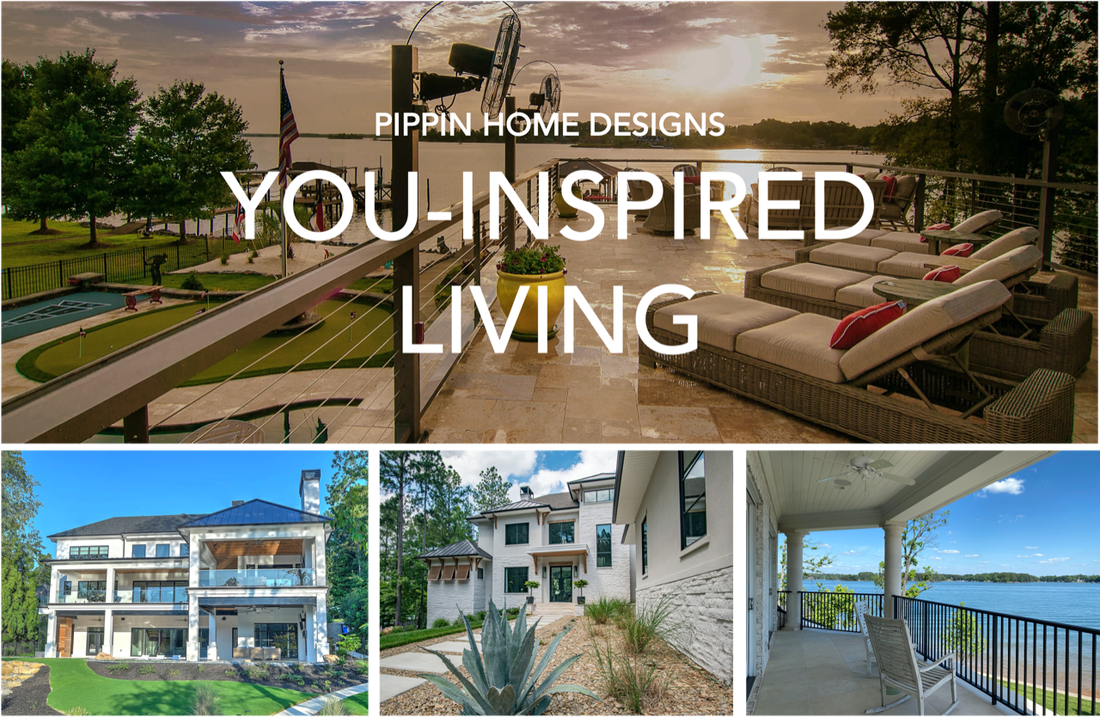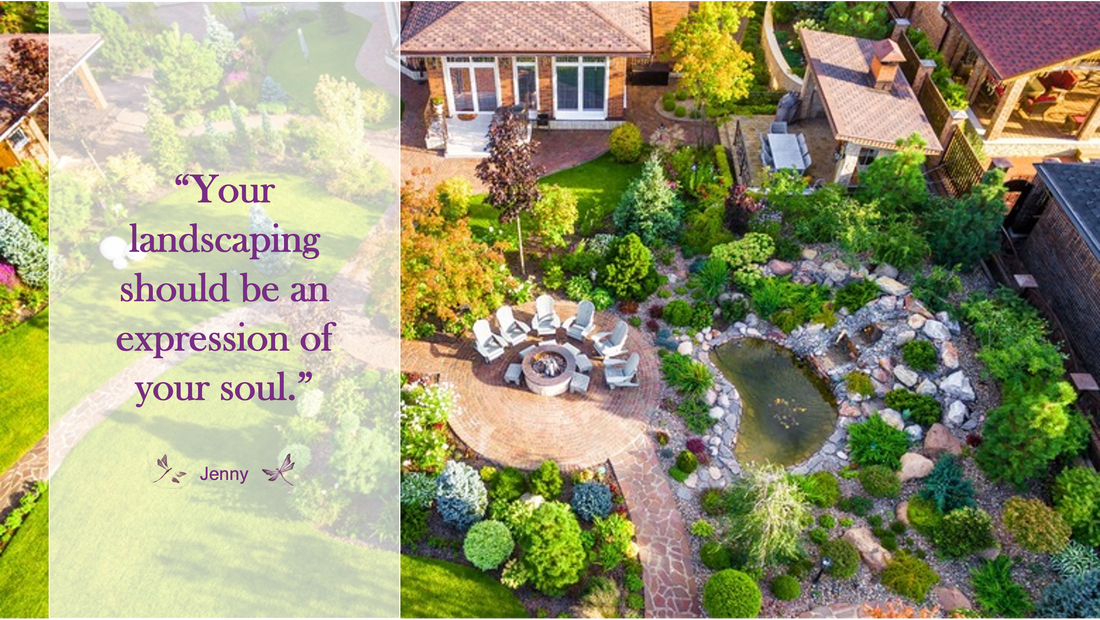
 Landscaping is often an afterthought or viewed as less important than the design of the home. However, landscaping impacts the way you FEEL about your home…and a home that feels good is a happy home. With the power to increase the value of your home AND the value of your life, landscaping MUST be integrated into your home design with consideration from the three essential viewpoints. In this final post of the Happy by Design series, I offer a visualization exercise to explain the three viewpoints you must consider to get the most out of your landscaping. Viewpoint #1: Curbside I’ll start with the most obvious viewpoint you need to consider when designing your landscaping. The view of your home from the street or point of entry is the first view you’ll see when coming home and the first impression received by visitors. It’s well known that landscaping from this viewpoint enhances curb appeal and adds value for resale. For these reasons, many people know they ought to landscape the curbside of their home, however I invite you to dive deeper into the intention behind this first view. Imagine driving into your driveway. What’s the first view you have of your property? How does this view change as you continue closer to the house? Is there an element of surprise where part or all of your home is hidden by larger vegetation till a bend in your drive? Or is there an openness that communicates, “all are welcome.” Does the entry to your property feel safe or exposed? Is your landscaping unique? Is it an expression of YOU? Does it bring you joy? Beauty invites us in, welcoming us home. When you see a beautiful yard, you’re drawn into it like a natural force that begs you to explore more. The landscaping of your home can literally invite people in and make them feel intrigue, safety, beauty, and awe. Likewise, this first view is what welcomes YOU home every day. What kind of landscaping makes YOU feel happy? In our last blog we discussed the importance of doing some soul work and looking at your specific archetypes to learn which style of landscaping speaks true to you. The more clarity you have on what brings you ultimate joy, the more empowered you’ll be to express your inspired life with inspired landscaping. Click HERE to learn more about Inspired Landscaping: How Your Archetypes Influence Design. Viewpoint #2: Within the Landscaping Itself Imagine standing in the middle of your backyard. Now, envision looking towards your home. What do you see? Do you see mature trees that provide shading and protection? Do you see plants that frame the windows nicely adding visual appeal to the exterior of your house? Or are the plants blocking the view from your windows? Now, imagine turning 360 degrees, viewing each area of your property from the middle of your yard. Are different areas of your property designed for specific activities, like fireside chats, outdoor dining, or games? Is each intended activity planned for properly with enough space, appropriate vegetation, and supportive hardscaping like walkways, decks, and protection from the elements? Is there a cohesive flow from space to space? And does your landscaping look natural, as Mother Nature would intend, or is it fabricated with exotic plants you struggle to keep alive? The intention of inspired landscaping is to invite you further into your yard to commune with nature. Intentional hardscaping supports your landscaping with the necessary walkways, paths, and patios designed to lead the way to special areas for outdoor activities. Knowing how you want to experience the natural setting around your home will dictate what landscaping and hardscaping is necessary. One of the great benefits of landscaping is the opportunity to rewild your yard and your life. In our blog, The Science Behind Biophilic Design to Heal Mind, Body, & Soul we point out that our inherent biophilia (love of life) draws us to natural settings that calm the nervous system, provide ease of the mind, enhance curiosity of the soul, and support our entire physiology. According to the famous landscape designer and environmentalist Mary Reynolds, "People travel the world over to visit untouched places of natural beauty, yet modern gardens pay little heed to the simplicity and beauty of these environments." She emphasizes the benefits wild natural settings have on humanity, and the devastating impact humanity has had on our wild spaces. Her solution is to design landscaping using a technique called “forest gardening” that works with the shapes and patterns found in nature while using native flowers and wildlife. She compares the process of gardening to "knitting or weaving a magic spell" which can allow "the land to become healed.” Perhaps we should heed her advice and recognize the importance of nurturing nature and landscaping for the land’s sake. Viewpoint #3: From Your Home This is the viewpoint that likely has the biggest impact on your life yet is the most overlooked. Your landscaping will be a component of every view you see from every window and every outdoor living space of your home. Imagine you’re walking throughout your home gazing out each window as you pass from room to room. Or perhaps you’re sitting on your covered porch looking out over your yard. What do you see? Can you see the views you want to see most? Or is your ideal view obscured by vegetation? Is your home lacking an ideal view altogether? Your landscaping should enhance the natural views already available. If your property is lacking an ideal view, intentional landscaping is your greatest opportunity to bring beauty to the views you’ll see from your house every single day. Do some rooms in your home have an undesirable view of a neighbor’s garage or an unsightly storage shed? Without mitigation from your landscaping these rooms will be far less likely to be visited and may become unused space within your house. Can you see the different areas of your yard where people are most likely to gather? How about areas where children play or where animals need to be tended? There needs to be a cohesive relationship between the way you want to live your life inside your home and the way you intend to live your life outside your home. Both must be considered and designed together in order to plan appropriately for all living spaces, inside and out. Historically, humans have spent a whopping 90% of their lives indoors which means that landscaping has predominantly been viewed from the inside. In response to the pandemic, we have fortunately shifted this behavior and people are requesting more outdoor living spaces for their homes than ever before. More people are insisting on outdoor dining areas, outdoor kitchens, year-round outdoor retreats, and some are even designing outdoor workspaces allowing them to escape the confines of the office altogether. Now, more than ever, the landscaping of your home has become an integral part of your everyday living. Let’s design landscaping that boosts your happiness, enhances views, connects people to places, and maximizes your exposure to biomorphic patterns like fractals that lends to your sense of wellbeing. Join us next month when we launch our Environmental Series with a breakthrough blog that defines Bio Architecture, a full spectrum form of architecture that turns to nature as its inspiration. I intend your landscaping brings you happiness from all perspectives of your home. Inspired by you, Jenny Pippin, CPBD, FAIBD, CGP
Pippin Home Designs
0 Comments
Leave a Reply. |
AuthorI am Jenny Pippin, founder of Pippin Home Designs and creator of my own inspired living. I grew up as an ordinary southern girl, working in the fields of my family’s tobacco farm. It didn’t take me long to realize I had greater gifts and so I chose to step into my power and create my own path in life, inspired by my heart’s true passion. (More on my personal story HERE!) Archives
February 2024
Categories
All
|
Copyright 2020. Pippin Home Designs. All rights reserved.
ARCHITECTURAL DESIGN COPYRIGHT NOTICE
1987-2024 Copyright. Jennifer B. Pippin FAIBD, CPBD. Pertaining to all home designs, drawings, and photographic imagery of completed designs
presented herein. No part of the contents of the design work presented on this website may be reproduced or transmitted in any form or
by any means, electronic or mechanical, for the purpose of replication or adaptation. This material is intended to provide accurate and
authoritative information about the design abilities and expertise of Jennifer B. Pippin FAIBD, CPBD and Pippin Home Designs.
ARCHITECTURAL DESIGN COPYRIGHT NOTICE
1987-2024 Copyright. Jennifer B. Pippin FAIBD, CPBD. Pertaining to all home designs, drawings, and photographic imagery of completed designs
presented herein. No part of the contents of the design work presented on this website may be reproduced or transmitted in any form or
by any means, electronic or mechanical, for the purpose of replication or adaptation. This material is intended to provide accurate and
authoritative information about the design abilities and expertise of Jennifer B. Pippin FAIBD, CPBD and Pippin Home Designs.







 RSS Feed
RSS Feed
